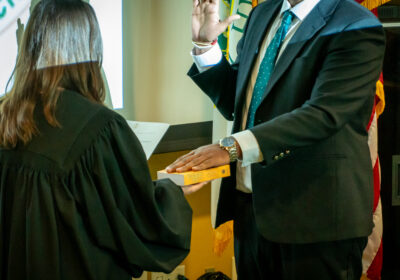Architect speaks to students about sustainable housing
As the worlds population increases, the size of housing is getting smaller in almost every major city around the globe.
But with his entertainment centers that turn into kitchens and minimalist arrangements, award-winning architect Gary Chang, who spoke to USF students on Tuesday night, has aimed to solve this problem.
In this new age of city dwelling we want something compact, useful and smart, he said.
What Chang is referring to is his style of architecture, which he said aims to maximize space and utility in small studio apartments throughout the world.
Changs lecture was the first in the School of Architecture and Community Designs Spring Lecture Series. More than 80 students packed the TECO room to hear Chang speak, with many students forced to sit on the floor due to a lack of seating.
Chang said he grew up in the densely-populated city of Hong Kong and clearly recalled the cramped living situation of his childhood apartment.
I lived in a small, three-bedroom apartment, no more than 260 square feet, Chang said. One room was occupied by my parents, one by my three sisters and one by a lodger who rented the room. My room was the living room and I think that is where I draw my interest in architecture, because I had to figure out how to make the living room my bedroom.
Chang graduated from the University of Hong Kong in 1987 with a degree in Architecture. In 1994, he went on to found EDGE, renaming it EDGE Design Institute Ltd. in 2003, and said the firm places high value on experimenting with design.
Following the economic boom and urbanization of China, the average size of housing in Hong Kong was reduced to approximately 12.1 square meters, he said. The result was multiple people co-existing in living conditions that were meant for one person a type of housing that would be deemed illegal in the U.S.
A reason why people stay in these conditions is that they find it a burden to traffic from the old towns to the new cities, Chang said. So they would rather live close, even in these conditions,
In his lecture, Chang showcased many of his apartments and houses that utilized innovations such as moving walls and the use of compartments to maximize free space. One item showcased was a piece of furniture which functioned as a bathtub cover, twin bed, personal desk and a sofa.
Chang is best known for the designing of his own apartment that he calls Domestic Transformer. The apartment has features such as a 2,000 CD shelf that doubles as a wall for his bathroom. In his living room, Changs entertainment center pulls out to reveal his compact kitchen and small bar.
When my parents moved out of my childhood apartment, I mortgaged it and used my own designs to reinvent it, Chang said.
Our work in the architecture department here at USF, and the university in general, focuses on sustainable design and extreme utility and I think Changs speech really highlighted those principles, Stanley said. Overall, I think we can take a lot of things that Chang has done and incorporate it into our own designs when its relevant.






